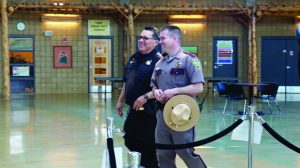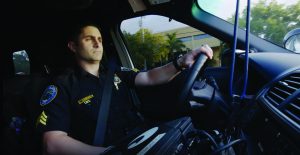The Advancing 21st Century Policing Initiative, launched by the Office of Community Oriented Policing Services and the IACP in 2016, worked with 15 law enforcement agencies diverse in size, location, and population served to showcase promising practices in contemporary community policing.
The practices and programs of these agencies led to the development of key considerations and case study examples for implementing contemporary community policing strategies within the topics of community participation and leadership; police-youth engagement; vulnerable populations; policing in small, rural, and tribal communities; and officer safety and wellness. The following are highlights from the Practices in Modern Policing series, which includes five publications and three videos.
Community Participation and Leadership
Community policing programs that facilitate community participation and leadership are a means through which law enforcement agencies can demonstrate the transparency and fairness on which procedural justice relies and engage the community as partners in public safety.
Best Practices and Recommendations
Collaborate from the very beginning. To create community policing programs that stimulate community participation and leadership, involve community members from the start. Consult community members to determine their needs before establishing programs, and invite them to co-create proposed programs. The result will be a program that involves the community as much as the police.
Embrace diversity. Community policing structures should be as diverse as the communities whose interests they represent. All committees, councils, and boards should have a demographic makeup that reflects the larger community’s diversity of race and ethnicity, age, gender, sexual orientation, faith, physical ability, income, and other characteristics.
Police-Youth Engagement
Interactions with youth present a distinct set of challenges and opportunities for law enforcement. By implementing or building on existing community policing programs, law enforcement can have a positive influence on youths’ perception of police and on police interaction with juveniles.
Best Practices and Recommendations
Identify youths and other leaders in the community who can help bridge the gap between youth and law enforcement. When discussing ways to best engage with youths, include persons who local youths can relate to and look up to. Involve youths who can serve as positive role models or community leaders who had trouble with the law or gangs when they were younger. If their role models have positive relationships with law enforcement, youth might begin to see law enforcement in a more positive light.
Take advantage of various types of social media platforms that youth use. By engaging with youth using the social media and apps that they use among themselves, law enforcement can gain credibility and a new forum through which to communicate. The use of apps such as Kik, WhatsApp, or Whisper can make law enforcement seem more informal and relatable. Focus on highlighting positive police-youth interactions.
 Serving Vulnerable Populations: Video and Publication
Serving Vulnerable Populations: Video and Publication
The communities where police officers work encompass a multitude of individuals with different ages, genders, incomes, races, ethnicities, religions, sexual orientations, abilities, health statuses, and occupations. As such, policing is not a one-size-fits-all endeavor. Adaptive approaches are especially important for policing vulnerable populations, including people who are elderly; undocumented; or experiencing homelessness, disability, substance abuse, or physical or mental illness.
Best Practices and Recommendations
Build a multidisciplinary coalition of community partners. Whole-community problems demand whole-community solutions. Law enforcement agencies should therefore take a collaborative approach to addressing challenges such as homelessness, mental health issues, and substance use disorders that permeate the criminal justice system but also reach well beyond it. Specifically, law enforcement agencies should build a multidisciplinary network of close-knit partners who can take coordinated action in support of individuals and against the systemic challenges those individuals face.
Embrace alternatives to arrest. Criminal arrest and prosecution are appropriate remedies for criminal acts. For minor offenses and noncriminal behavior, however, book-and-release tactics can be expensive, ineffective, and unjust, perpetuating and exacerbating challenges in vulnerable populations instead of resolving them. Law enforcement agencies should empower police officers and deputies to use alternative remedies in those circumstances, such as drug and alcohol treatment, hospitalization, and other diversionary programs, when appropriate, as these outlets can simultaneously help community members, save money, and reduce recidivism.
 Policing in Small, Rural, and Tribal Communities: Video and Publication
Policing in Small, Rural, and Tribal Communities: Video and Publication
Despite often having lower crime rates, small, rural, and tribal communities have their own public safety needs, the responsibility for which belongs to law enforcement agencies whose location, size, and composition create challenges and opportunities that differ from those in large metropolitan areas. Community-oriented policing can help small, rural, and tribal law enforcement agencies overcome those challenges through partnerships, problem-solving, and creative organizational design.
Best Practices and Recommendations
Foster collaborative partnerships. Although they typically serve fewer people than urban police departments, small, rural, and tribal law enforcement agencies perform the same core functions. But because smaller size often means not only fewer resources, but also fewer officers per capita, small, rural, and tribal agencies commonly have to do more with less. Smaller departments depend on their relationships with community organizations, other government agencies, and state and local law enforcement partners. Mapping out community resources and making personal connections can help smaller agencies creatively address public safety issues, share resources, and enhance officer safety.
Empower officers as community ambassadors. Beyond calls for service, smaller agency officers can take more time to assess and respond to the needs of the community. Officers who work for small, rural, and tribal police departments often have the opportunity to take on duties and responsibilities they otherwise wouldn’t—including work that would be done by special units in larger agencies; activities that complement officers’ personal interests, like sports-related community events; and other duties that have a direct and immediate impact on their agencies or communities.
 Officer Safety and Wellness: Video and Publication
Officer Safety and Wellness: Video and Publication
In order to secure and protect the communities they serve, police officers must have access to the tools and resources they need to secure and protect their own health and safety. In order to be effective, those tools and resources must address all facets of officer safety and wellness—including occupational, physical, and mental health.
Best Practices and Recommendations
Take a holistic approach to health, wellness, and safety. To serve communities effectively, officers must be healthy in mind, body, and spirit. Successful wellness and safety programs are therefore multifaceted, taking a 360-degree approach that encompasses physical health, mental health, family wellness, and spiritual wellness.
Build top-down support to promote and model healthy behaviors. It’s not enough for officer wellness and safety to be programmatic; in order to be successful, it must be pervasive. Law enforcement agencies must therefore create a wellness culture that permeates every level of their organization—starting at the top. A wellness culture is one in which senior leaders initiate, support, promote, and actively participate in efforts to fund and facilitate officer health, safety, and wellness. When senior leaders outwardly embrace wellness and safety, it sends a message that officer health is a fundamental and strategic priority for the agency.
Conclusion
Law enforcement agencies are fixtures in their communities. Modern-day policing should facilitate partnerships and accountability in order to be most effective, both of which law enforcement agencies can nurture with community policing strategies as outlined in the Practices in Modern Policing re source series. For the full list of considerations and more information, download each of the five publications and view the three videos on the IACP website.


